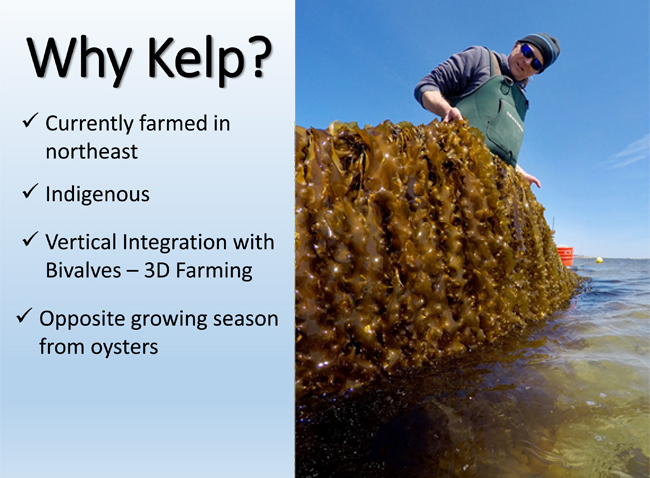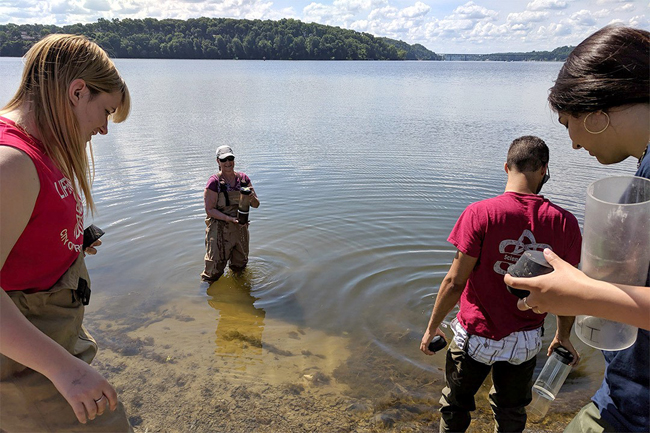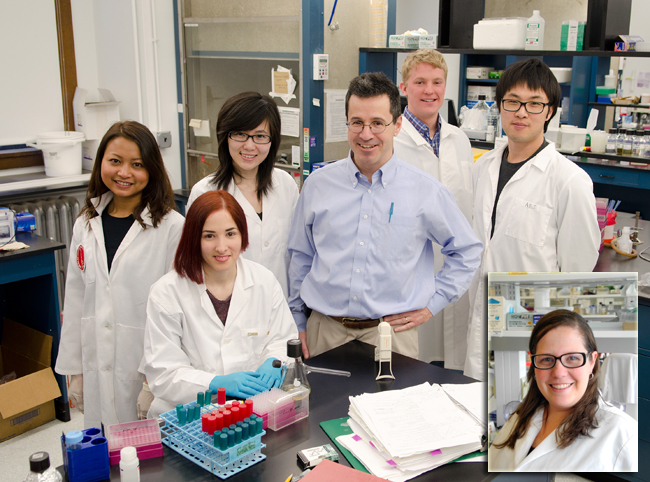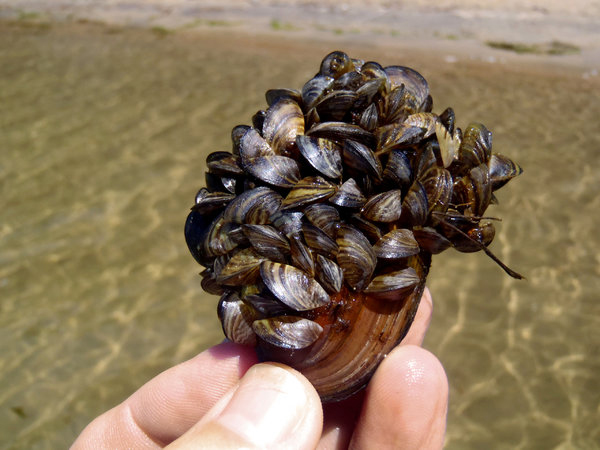Contact:
Lane Smith, Research Program Coordinator, NYSG, E: lane.smith@stonybrook.edu, P: (631) 632-9780
Stony Brook, NY, March 29, 2023 - For more than five decades, New York Sea Grant (NYSG) has been supporting university-based research related to a variety of marine, Hudson estuary, and Great Lakes topics and issues.
Here are some summaries for recently-completed investigations that address a variety of concerns within a few key topics, including:
(a) Coastal Ecosystems — (1) identifying the potential impacts microplastics can have in the nearshore sediments of Lake Ontario; (2) evaluating new methods using genetic tools that provide an opportunity to detect aquatic invasive species (plants and animals) earlier in their invasion process.
(b) Fisheries, Seafood and Aquaculture — (1) exploring the use of sugar kelp to expand aquaculture and help control a variety of harmful algal blooms in New York’s marine waters; (2) assisting salmon processors with the use of the antibacterial nisin for an overall goal of improving food safety;
(c) Coastal Resiliency — After unprecedented high water levels and record flooding in 2017 and 2019 was a challenge for coastal communities along Lake Ontario, investigators gathered information to aid communities needing to apply for assistance through The New York Climate Smart Communities Program.

Sugar kelp, a brown rubbery plant that can grow underwater fronds 15 feet long, have been shown to help control a variety of HABs. NYSG-supported researchers have developed and are testing shellfish aquaculture techniques that integrate macroalgae culture. Credit: Micahel Doall
The Use of Macroalgae to Expand Aquaculture and Prevent, Control, and Mitigate Harmful Algal Blooms in New York’s Coastal Zones (R/ATD-14, Dr. Christopher Gobler, Stony Brook University)
For the past several decades New York’s coastal waters have undergone an increase of human-caused nutrient loading that contributed to many serious and diverse Harmful Algal Blooms (HABs). These blooms have had severe ecosystem and economic impacts. A variety of efforts have been taken to reduce the severity and consequence of HABs. Studies in Asia have shown that many species of macroalgae can inhibit the growth of and potentially kill a broad range of microalgae, including multiple HAB species.
Stony Brook University principal investigator Dr. Chris Gobler examined the link between HABs and macroalgae aquaculture in a project aimed at assessing the ability of cultivable macroalgae species to inhibit the growth of HAB species common to NY waters while expanding opportunities for aquaculture. Project results demonstrated the ability of Saccharina latissima (sugar kelp) to inhibit the growth and toxicity of the domoic acid-producing diatom, Pseudo-nitzschia multiseries. Additionally, investigators discovered the ability of the green macroalga Ulva to inhibit the growth and toxicity of the okadaic acid-producing HAB, Dinophysis acuminata. Researchers also discovered the ability of Ulva to inhibit the growth and toxicity of the ichthyotoxic HAB, Cochlodinium polykrikoides. Field cultivation techniques developed on Long Island oyster farms showed that sugar kelp is highly effective at combating HABs.

RIT researchers studied the effects of microplastic pollution on Lake Ontario. This NYSG-funded research provided information on the potential impacts microplastics can have on the ecosystem services in Great Lakes sediments. RIT Associate Professor Christy Tyler, center, is pictured collecting sediment samples in Irondequoit Bay in 2019. Credit: Matthew Hoffman/RIT
Impacts of Microplastic Pollution on Benthic Ecosystem Functions and Services (R/CTP-55, Dr. Christy Tyler, Rochester Institute of Technology)
Microplastic pollution has been found in diverse marine, freshwater, and terrestrial ecosystems. The scientific consensus is that plastic debris impacts aquatic systems at all levels of biological organization. The majority of existing microplastic research focuses on oceans or the open water zones of lakes. Though relatively high concentrations of plastics are found in freshwater sediments, the data are sparse. Questions remain regarding the potential impacts of microplastics on sediment ecosystem processes. There is insufficient spatial and temporal resolution of plastic debris quantity and quality in the Great Lakes to effectively inform policy, mitigation, management strategies, and the design of targeted research.
A research team at Rochester Institute of Technology led by Dr. Christy Tyler aimed to address this knowledge gap by combining sediment sample analysis with three-dimensional transport modeling to produce the first estimates of polymer-specific plastic flux to the sediment. Results of experiments on chemical degradation, biofilm formation, toxicity, and impact on the ecosystem function of microplastics illustrate that the changes in polymers are variable and highly site-specific. For example, toxicity increased for polymers incubated in the coastal zone of Lake Ontario but decreased for those incubated in a stormwater retention pond in the watershed. Also, results showed that the activities of worms in the sediment increase the rate of burial of microplastic particles, suggesting that once particles reach the benthos, they will be retained within the sediment. However, specific polymers reduced the impact of worms on ecosystem metabolism and nutrient cycling. Overall, the results of the project demonstrate that the ecosystem impacts of microplastics in nearshore Lake Ontario are the result of a complex interaction of polymer type, biofilm formation, site characteristics, particle transport, and interactions with organisms.

Unprecedented high water levels and record flooding in 2017 and 2019 was a challenge for coastal communities along Lake Ontario. NYSG-funded research has provided information that will help communities apply for assistance through The New York Climate Smart Communities Program. Credit: Mary Austerman/NYSG
Using Hydroclimate Modeling and Social Science to Enhance Flood Resilience on Lake Ontario Through the Climate Smart Communities Program (R/CHD-15, Dr. Scott Steinschneider, Cornell University)
The New York Climate Smart Communities (CSC) Program is a New York State program that helps local governments adapt to a changing climate. Part of the program offers competitive grants with 50% matching funds for projects to improve the resilience of coastal communities. However, participation in the program among Lake Ontario municipalities, recently impacted by several flooding events, is low, in part because of the requirement for municipalities to demonstrate the need for a project based on an assessment of future conditions derived from scientifically supported climate projections.
Cornell University investigator Dr. Scott Steinschneider (in partnership with the Genesee/Finger Lakes Regional Planning Council) led a research team that integrated modeling tools and social-science-based recommendations to help Lake Ontario coastal communities better meet the CSC Program requirements and adapt to future coastal flooding. The researchers successfully produced an integrated modeling framework of Lake Ontario hydrology, water level management, and flood inundation that local communities can use to more easily apply for state funding under the CSC program to improve their flood resilience. Results of focus groups and interviews with municipal and county officials provided a better understanding of the barriers to CSC participation. A result was the development of a crosswalk tool between the CSC program and other federal and state flood resiliency programs that help streamline participation in multiple flood resiliency programs at once.

Research by Dr. Martin Wiedemann (seen in his laboratory with technicians) and post-doc associate Dr. Veronica Guariglia (inset) assisted salmon processors with the use of the antibacterial nisin. Credit: Cornell University
Development and Optimization of Precise Listeria monocytogenes Control Strategies for Smoked Seafood (R/SHH-18, Dr. Martin Wiedmann, Cornell University)
While foodborne illness-causing Listeria monocytogenes (LM) typically contaminates food at low levels that are unlikely to cause human disease, it can grow to potentially disease-causing levels during refrigerated storage of many ready-to-eat foods, such as cold-smoked salmon (CSS). Studies have shown that current antimicrobial strategies (e.g., nisin application) against LM are affected by environmental conditions. There is a need in the industry to validate and optimize LM control strategies under actual conditions relevant to CSS.
A research project conducted by Dr. Martin Wiedmann at Cornell University studied seafood-relevant pre-growth conditions that may reduce nisin treatment efficacy against LM on cold-smoked salmon and explored potential approaches that can be used to increase nisin treatment efficacy under realistic conditions. The project developed a “Recall Risk Model”, a decision-support tool for cold-smoked salmon producers to estimate the probability of a recall event due to LM contamination. For example, the preliminary scenario analyses of the Recall Risk Model indicate that treating cold-smoked salmon products with 20 ppm nisin is able to result in a reduction of the recall risk and public health risk associated with LM contamination of cold-smoked salmon. Complementary to existing risk assessment models, this model can be used by cold-smoked salmon producers to optimize interventions and make science-based and timely decisions to achieve the overall goal of improving food safety (e.g., lowering prevalence and level of LM contamination) and reducing the public health risk of listeriosis.

A cluster of invasive zebra mussels attached to a native freshwater mussel. Such infestations lead to the larger mussel’s death. Credit: D. P. Molloy/University at Albany
Development of a Cost-Effective, Standardizable, Environmental DNA Method for the Simultaneous Detection of Multiple Coastal Invasive Species (R/XG-28, Dr. David Lodge, Cornell University)
Aquatic invasive species (AIS) is an ongoing management issue for State environmental managers. As new non-native species arrive, there exists the possibility that the invader could have significant ecological and economic impacts. Barring the prevention of new arrivals, the next best thing is early detection. Early detection provides time to assess the potential impact of the species based on its biology and ecology. If detected early enough, this can provide an opportunity to eradicate the newcomer, or more likely, slow or limit its spread and limit its potential impacts. Traditional sampling methods usually don’t detect new AIS until they are fairly abundant and well-established. New methods using genetic tools provide the opportunity to detect new AIS earlier. A recent tool currently being tested makes use of environmental DNA (eDNA). Environmental DNA tools provide a method to rapidly and affordably detect the DNA of multiple species in water samples. These are useful features for environmental managers.
A research team led by Dr. David Lodge at Cornell University developed a cost-effective and potentially standardizable multiple-amplicon eDNA method to conduct early detection of multiple targeted species in a single assay. Current assays are either time-consuming or prohibitively expensive and complex for many management agencies, especially when there is a need to target multiple species. The eDNA assay developed from this research provides a technology to conduct active, targeted, early detection of multiple high-risk invasive species in New York State’s coastal waters. The eDNA tool was successfully tested and applied in four of NY’s Great Lakes harbors and New York Harbor, detecting several invasive species of interest to managers. The new eDNA technique makes it possible to simultaneously detect multiple aquatic invasive species (plants and animals) earlier in the invasion process than traditional whole-organism sampling, allowing for earlier management intervention and increasing eradication chances and decreasing spread. Regional stakeholders interested in the immediate application of the new techniques include staff of NY’s PRISM network, the NYSDEC, and academic institutions interested in invasive species genetics.
More Info: New York Sea Grant
New York Sea Grant (NYSG), a cooperative program of Cornell University
and the State University of New York (SUNY), is one of 34 university-based
programs under the National Oceanic and Atmospheric Administration’s
National Sea Grant College Program.
Since 1971, NYSG has represented a statewide network of integrated
research, education and extension services promoting coastal community
economic vitality, environmental sustainability and citizen awareness
and understanding about the State’s marine and Great Lakes resources.
Through NYSG’s efforts, the combined talents of university scientists
and extension specialists help develop and transfer science-based
information to many coastal user groups—businesses and industries,
federal, state and local government decision-makers and agency managers,
educators, the media and the interested public.
The program maintains Great Lakes offices at Cornell University, SUNY
Buffalo, SUNY Oswego and the Wayne County Cooperative Extension office
in Newark. In the State's marine waters, NYSG has offices at Stony Brook
University in Long Island, Brooklyn College and Cornell Cooperative
Extension in NYC and Kingston in the Hudson Valley.
For updates on Sea Grant activities: www.nyseagrant.org has RSS, Facebook, Twitter, Instagram, and YouTube links. NYSG offers a free e-list sign up via www.nyseagrant.org/nycoastlines for its flagship publication, NY Coastlines/Currents, which is published quarterly.